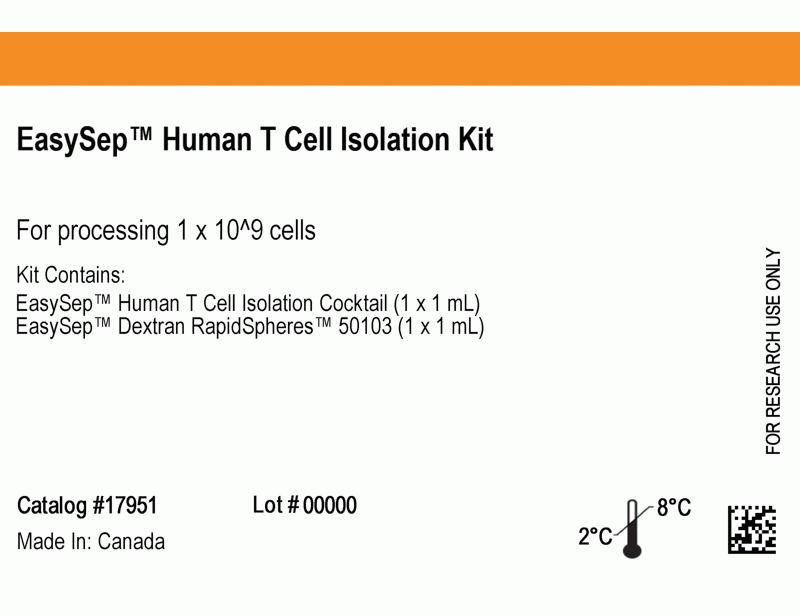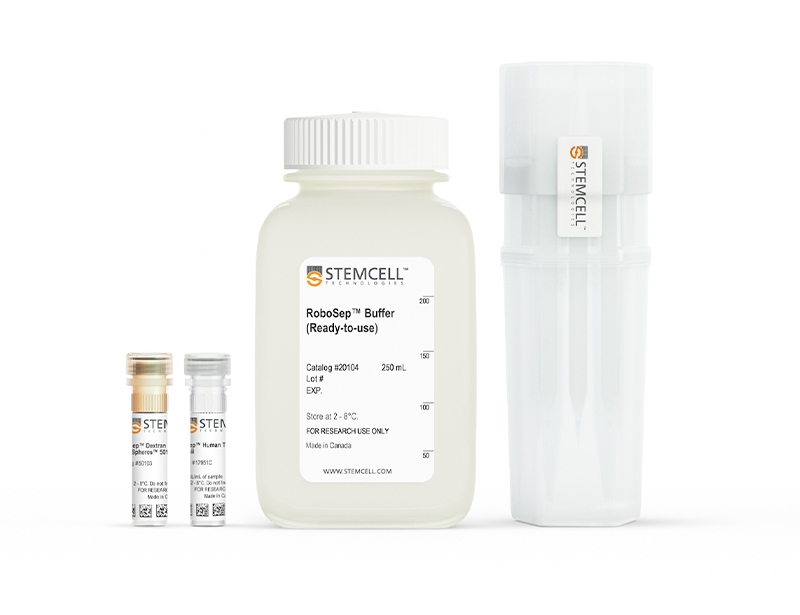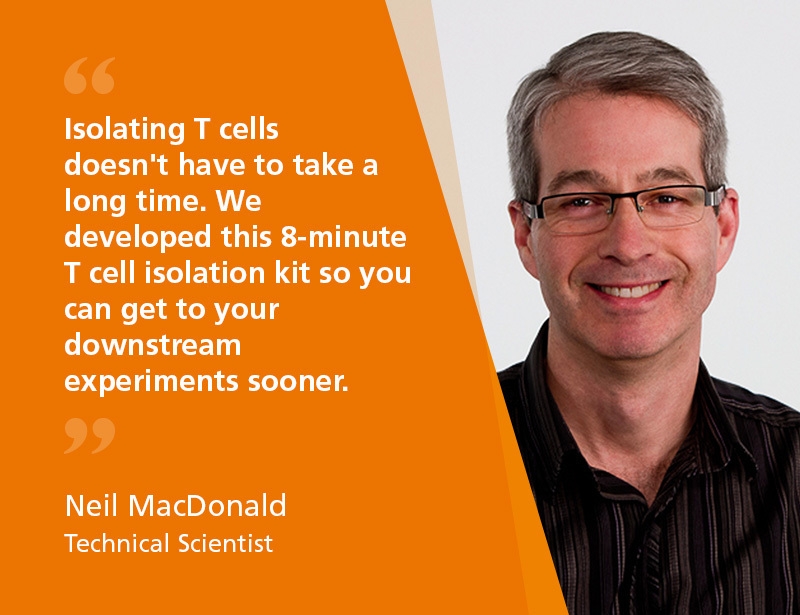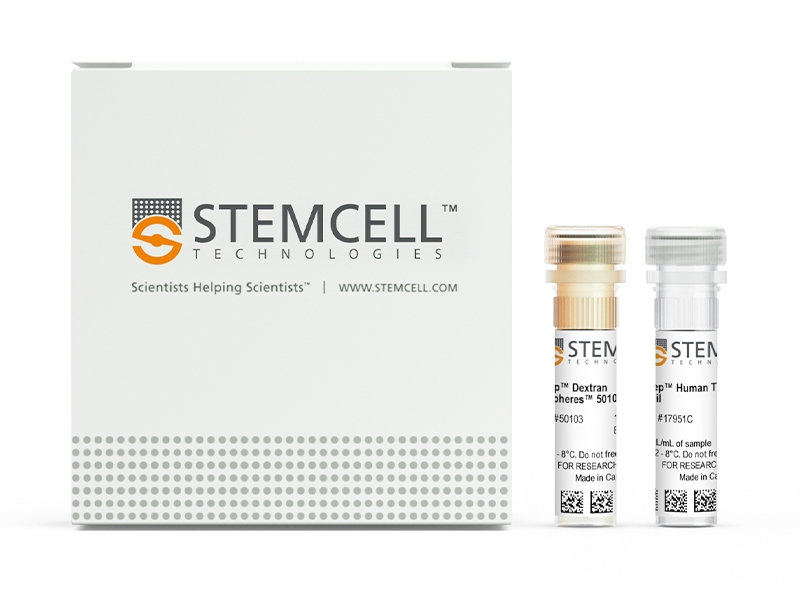概要
The EasySep™ Human T Cell Isolation Kit is designed to isolate T cells from fresh or previously frozen peripheral blood mononuclear cells or washed leukapheresis samples by immunomagnetic negative selection. The EasySep™ procedure involves labeling unwanted cells with antibody complexes and magnetic particles. The magnetically labeled cells are separated from the untouched desired cells by using an EasySep™ magnet and simply pouring or pipetting the desired cells into a new tube.
This product can be used in place of the EasySep™ Human T Cell Enrichment Kit (Catalog #19051) for even faster cell isolations.
This product can be used in place of the EasySep™ Human T Cell Enrichment Kit (Catalog #19051) for even faster cell isolations.
技术资料
| Document Type | 产品名称 | Catalog # | Lot # | 语言 |
|---|---|---|---|---|
| Product Information Sheet | EasySep™ Human T Cell Isolation Kit | 17951 | All | English |
| Product Information Sheet | RoboSep™ Human T Cell Isolation Kit | 17951RF | All | English |
| Safety Data Sheet 1 | EasySep™ Human T Cell Isolation Kit | 17951 | All | English |
| Safety Data Sheet 2 | EasySep™ Human T Cell Isolation Kit | 17951 | All | English |
| Safety Data Sheet 1 | RoboSep™ Human T Cell Isolation Kit | 17951RF | All | English |
| Safety Data Sheet 2 | RoboSep™ Human T Cell Isolation Kit | 17951RF | All | English |
数据及文献
Data
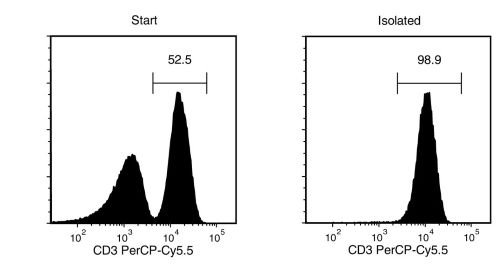
Figure 1. EasySep™ Human T Cell Isolation Kit
Starting with human peripheral blood mononuclear cells (PBMCs), the T cell content (CD3+) of the isolated fraction is typically 96.7 ± 1.5% (mean ± SD).
Publications (11)
Journal of clinical medicine 2020 may Inflammation-Induced Mucosal KYNU Expression Identifies Human Ileal Crohn's Disease.
Abstract
Abstract
The widely varying therapeutic response of patients with inflammatory bowel disease (IBD) continues to raise questions regarding the unclarified heterogeneity of pathological mechanisms promoting disease progression. While biomarkers for the differentiation of Crohn's disease (CD) versus ulcerative colitis (UC) have been suggested, specific markers for a CD subclassification in ileal CD versus colonic CD are still rare. Since an altered signature of the tryptophan metabolism is associated with chronic inflammatory disease, we sought to characterize potential biomarkers by focusing on the downstream enzymes and metabolites of kynurenine metabolism. Using immunohistochemical stainings, we analyzed and compared the mucosal tryptophan immune metabolism in bioptic samples from patients with active inflammation due to UC or CD versus healthy controls. Localization-specific quantification of immune cell infiltration, tryptophan-metabolizing enzyme expression and mucosal tryptophan downstream metabolite levels was performed. We found generally increased immune cell infiltrates in the tissue of all patients with IBD. However, in patients with CD, significant differences were found between regulatory T cell and neutrophil granulocyte infiltration in the ileum compared with the colon. Furthermore, we observed decreased kynurenine levels as well as strong kynureninase (KYNU) expression specifically in patients with ileal CD. Correspondingly, significantly elevated levels of the kynurenine metabolite 3-hydroxyanthranilic acid were detected in the ileal CD samples. Highlighting the heterogeneity of the different phenotypes of CD, we identified KYNU as a potential mucosal biomarker allowing the localization-specific differentiation of ileal CD versus colonic CD.
Cell 2020 aug An Activity-Guided Map of Electrophile-Cysteine Interactions in Primary Human T Cells.
Abstract
Abstract
Electrophilic compounds originating from nature or chemical synthesis have profound effects on immune cells. These compounds are thought to act by cysteine modification to alter the functions of immune-relevant proteins; however, our understanding of electrophile-sensitive cysteines in the human immune proteome remains limited. Here, we present a global map of cysteines in primary human T cells that are susceptible to covalent modification by electrophilic small molecules. More than 3,000 covalently liganded cysteines were found on functionally and structurally diverse proteins, including many that play fundamental roles in immunology. We further show that electrophilic compounds can impair T cell activation by distinct mechanisms involving the direct functional perturbation and/or degradation of proteins. Our findings reveal a rich content of ligandable cysteines in human T cells and point to electrophilic small molecules as a fertile source for chemical probes and ultimately therapeutics that modulate immunological processes and their associated disorders.
Science advances 2019 jan Multiplexed enrichment and genomic profiling of peripheral blood cells reveal subset-specific immune signatures.
Abstract
Abstract
Specialized immune cell subsets are involved in autoimmune disease, cancer immunity, and infectious disease through a diverse range of functions mediated by overlapping pathways and signals. However, subset-specific responses may not be detectable in analyses of whole blood samples, and no efficient approach for profiling cell subsets at high throughput from small samples is available. We present a low-input microfluidic system for sorting immune cells into subsets and profiling their gene expression. We validate the system's technical performance against standard subset isolation and library construction protocols and demonstrate the importance of subset-specific profiling through in vitro stimulation experiments. We show the ability of this integrated platform to identify subset-specific disease signatures by profiling four immune cell subsets in blood from patients with systemic lupus erythematosus (SLE) and matched control subjects. The platform has the potential to make multiplexed subset-specific analysis routine in many research laboratories and clinical settings.
Cell reports 2018 AUG Identification of an Early Unipotent Neutrophil Progenitor with Pro-tumoral Activity in Mouse and Human Bone Marrow.
Abstract
Abstract
Neutrophils are short-lived cells that play important roles in both health and disease. Neutrophils and monocytes originate from the granulocyte monocyte progenitor (GMP) in bone marrow; however, unipotent neutrophil progenitors are not well defined. Here, we use cytometry by time of flight (CyTOF) and single-cell RNA sequencing (scRNA-seq) methodologies to identify a committed unipotent early-stage neutrophil progenitor (NeP) in adult mouse bone marrow. Importantly, we found a similar unipotent NeP (hNeP) in human bone marrow. Both NeP and hNeP generate only neutrophils. NeP and hNeP both significantly increase tumor growth when transferred into murine cancer models, including a humanized mouse model. hNeP are present in the blood of treatment-naive melanoma patients but not of healthy subjects. hNeP can be readily identified by flow cytometry and could be used as a biomarker for early cancer discovery. Understanding the biology of hNeP should allow the development of new therapeutic targets for neutrophil-related diseases, including cancer.
Frontiers in immunology 2018 Fam65b Phosphorylation Relieves Tonic RhoA Inhibition During T Cell Migration.
Abstract
Abstract
We previously identified Fam65b as an atypical inhibitor of the small G protein RhoA. Using a conditional model of a Fam65b-deficient mouse, we first show that Fam65b restricts spontaneous RhoA activation in resting T lymphocytes and regulates intranodal T cell migration in vivo. We next aimed at understanding, at the molecular level, how the brake that Fam65b exerts on RhoA can be relieved upon signaling to allow RhoA activation. Here, we show that chemokine stimulation phosphorylates Fam65b in T lymphocytes. This post-translational modification decreases the affinity of Fam65b for RhoA and favors Fam65b shuttling from the plasma membrane to the cytosol. Functionally, we show that the degree of Fam65b phosphorylation controls some cytoskeletal alterations downstream active RhoA such as actin polymerization, as well as T cell migration in vitro. Altogether, our results show that Fam65b expression and phosphorylation can finely tune the amount of active RhoA in order to favor optimal T lymphocyte motility.
Nature communications 2017 NOV Structure of human immunoproteasome with a reversible and noncompetitive inhibitor that selectively inhibits activated lymphocytes.
Abstract
Abstract
Proteasome inhibitors benefit patients with multiple myeloma and B cell-dependent autoimmune disorders but exert toxicity from inhibition of proteasomes in other cells. Toxicity should be minimized by reversible inhibition of the immunoproteasome β5i subunit while sparing the constitutive β5c subunit. Here we report β5i-selective inhibition by asparagine-ethylenediamine (AsnEDA)-based compounds and present the high-resolution cryo-EM structural analysis of the human immunoproteasome. Despite inhibiting noncompetitively, an AsnEDA inhibitor binds the active site. Hydrophobic interactions are accompanied by hydrogen bonding with β5i and β6 subunits. The inhibitors are far more cytotoxic for myeloma and lymphoma cell lines than for hepatocarcinoma or non-activated lymphocytes. They block human B-cell proliferation and promote apoptotic cell death selectively in antibody-secreting B cells, and to a lesser extent in activated human T cells. Reversible, β5i-selective inhibitors may be useful for treatment of diseases involving activated or neoplastic B cells or activated T cells.

 网站首页
网站首页
